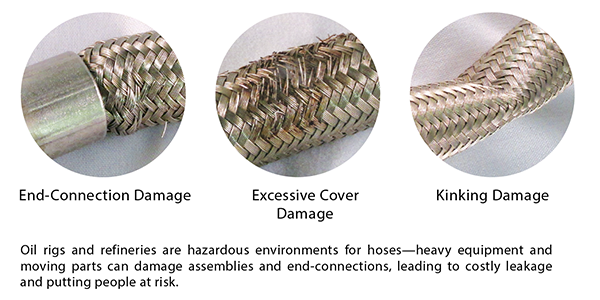Avoid safety incidents, environmental degradation, and system damage
Did you know that one of the most overlooked (and potentially costly) areas of oil and gas operations is hose assemblies?
If you spend some more time thinking about hose assemblies, you can help prevent hose failure. Here are five key field observations from an experienced Hose Advisory Services specialist:
1. Hoses don’t get the attention they deserve.
Hose is not a widely thought-about area of the plant. Most customers have specifications on tubing, fittings, and valves on pressure-containing systems and adhere to them, but hose is rarely given the same consideration.
That’s alarming because hose is part of this pressure system, too, and is one of the most likely components to fail.
2. Reconsider your requirements.
Today a lot of companies are trying to get more production from their machines and processes, which can mean greater system pressures, temperatures, and vibration. In such cases, hoses that no longer meet the original design requirement should be replaced with products rated to a higher standard.
When selecting new hose, pay close attention to the allowable pressures and safety factor. For instance, Swagelok designs all of its products with a 4:1 safety factor.
3. Failures cost more than you think.
Not only can costs add up over time, but a hose leak or break can cost you tens or hundreds of thousands of dollars at once. One leak was costing a company $10,000 USD an hour in fluid loss. Our inspection discovered the source of the leak, and we found a way to keep it from happening again.
4. The risks are real.
Risks of hoses are a very common thing as many safety alert bulletin boards can tell you, unfortunately. Steam can be invisible, high-pressure fluids can shoot out, and dangerous gases can be inhaled by anyone walking by where a hose has failed.
Hoses assembled on-site by mobile suppliers often are not pressure tested prior to installation, and, consequentially, they may pose a real safety risk. When you think of the consequences, you see why more thought must be given to hoses.
5. It’s easy to make improvements.
Fundamental training should be undertaken every few years to give staff an awareness of correct procedures for hose installation and maintenance. Engineers and designers should also have a high-level understanding so that potential risks can be minimized when designing an application or system. Following best practices from the start can proactively solve the majority of the problems we encounter.
Because of increasing liabilities to companies, customers need to be fully informed when selecting any pressure-containing component — especially hose.
Steps to simplify hoses:
1. Conduct an application audit.
Swagelok can assist by walking your facility with you to formally document different hose/assembly types.
2. Set a preventive maintenance schedule.
By monitoring hoses and forecasting their future life, companies can reduce the risk of injury and downtime. Scheduled shutdowns are an ideal time to inspect and replace hoses pre-emptively.
3. Standardize on fewer selections.
Customers often have multiple applications where the same hose can be used, but they are unaware of it. By standardising sizes, lengths, and
end-connections across the operation, it is possible to greatly reduce the number of critical spares needed and lower your costs at the same time.
An on-site audit is the place to start.
The Swagelok Hose Advisory Service (HAS) can help you to extend the life and performance of your hoses in all applications. By sharing our expert knowledge in fluid system design, we can help you maximize the life of your hose.


